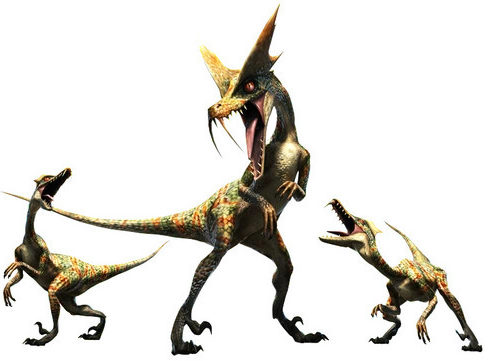 Social pack-hunting Bird Wyverns with green and orange scales covering their bodies. Their most prominent features are the pair of backwards-pointing crests above their eyes and the pair of oversized fangs in their jaws. Their forelimbs each have three clawed digits, and each of their hindlimbs bear an enlarged claw on the first digit which is held off the ground.
Social pack-hunting Bird Wyverns with green and orange scales covering their bodies. Their most prominent features are the pair of backwards-pointing crests above their eyes and the pair of oversized fangs in their jaws. Their forelimbs each have three clawed digits, and each of their hindlimbs bear an enlarged claw on the first digit which is held off the ground.
Mature adults are known as Gendromes while immature subadults are known as Genprey. As the alpha leader of the pack, Gendromes are larger in size and have a larger pair of crests. These crests are used for sexual appeal by showing that the Gendrome is sexually mature. Packs are only led by one dominant Gendrome, as the other adults are chased away upon reaching maturity to look for another pack to take over. [It's probable that a breeding Gendrome pair will temporarily unite their packs during the breeding season.]
Typically, Genprey and Gendrome packs are found in open environments like deserts and more sparsely forested areas compared to Velociprey and Velocidrome, where their coloration is an adaptation to camouflage better in these areas. They mainly prey on Herbivores such as Apceros and Aptonoth. Besides that, they often scavenge carrion from the kills of larger wyverns.
Being pack hunters, Genprey and Gendrome are relatively intelligent and their highly-developed brains allow them to formulate hunting plans quite quickly. When hunting, they use a range of calls to communicate with each other to cooperate effectively. [Their large, red eyes likely give them good eyesight.] As they inhabit open areas where prey can escape easily, they have evolved paralytic venom in their fangs and claws capable of paralysing prey ten times their size in mere seconds. It is also likely that their venom has also evolved to deal with armoured prey such as Apceros and Rhenoplos. They are immune to their own venom, as the skin under their scales is able to neutralise the paralytic toxins. Their packs can pose a major threat to the general public as they are more common than some of the aggressive Flying Wyverns that are native to the areas they inhabit.
Genprey and Gendrome are quite low in the food chain and can easily end up as prey for larger wyverns, though their speed and agility usually discourages that. Their neurotoxic venom is also capable of paralyzing large Flying Wyverns. Despite that, they are still often attacked by the aggressive herbivorous Monoblos and Diablos, and Shrouded Nerscylla may even feed on them to sequester their neurotoxins for their own use. [Other monsters like Tigerstripe Zamtrios or even Desert Seltas may do so as well, but this is unconfirmed.]
Genprey and Gendrome are closely related to Velociprey and Velocidrome, Giaprey and Giadrome, as well as Ioprey and Iodrome.
Genprey and Gendrome are closely related to Velociprey and Velocidrome, Giaprey and Giadrome, as well as Ioprey and Iodrome.
No comments:
Post a Comment